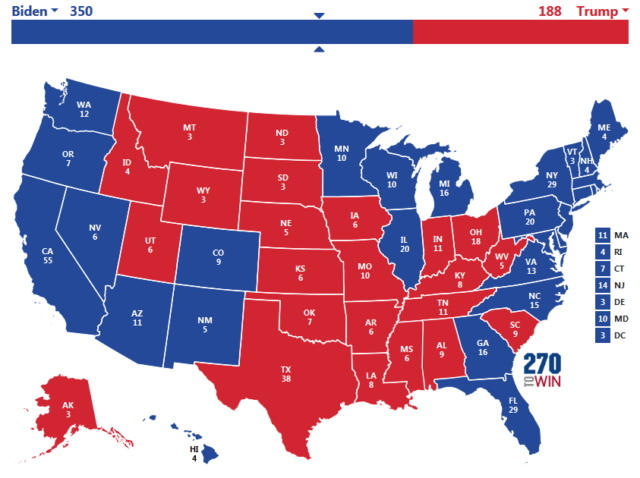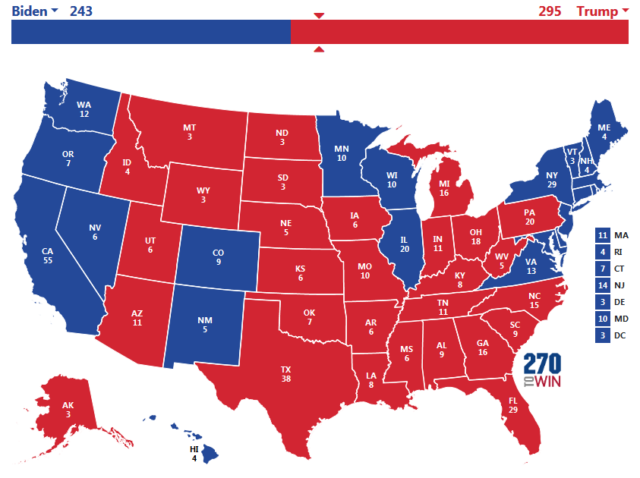I try to keep politics out of this site, except when politics has an impact on the marketplace. As long as this is the case, I’ll continue to comment about politics and this week definitely warrants some comment about it.
I’d like to preface this by explicitly outlining my level of emotional involvement in the presidential election. There is none. Whether Biden, Trump or anybody else wins the presidency, doesn’t matter much to me personally. I’m not like a spectator cheering for my preferred sports team; I’m a detached observer that is trying to predict who will win for the purposes of determining what set of policies will get implemented, and these policies will give certain sectors tailwinds that are worthy of investment, and certain sectors headwinds that you will want to steer clear. Look no further than any natural resource investment in Canada, especially post-Bill C-69, which is the incumbency protection bill for any company with an existing pipeline or natural resource project. Pipeline? Nope, unless if the government nationalizes it! Coal mine expansion? Sorry, you’re toast!
Again, winners and losers come out of any political changes in office. It is not my job to get happy or upset at any particular candidate or party, but rather to figure out what is likely to happen as a consequence and take appropriate action. My prediction of Trump winning is not out of any love for him but how I see it (although I will confess that he is ten times more entertaining to watch than Hillary Clinton or Joe Biden will ever be – it is undeniable he is a truly unique character in politics).
The point of this – some people confuse a prediction of a winner as some sort of endorsement. It is not.
Anyhow, my 2020 prediction was essentially correct. It doesn’t matter that Trump actually wins or loses the electoral votes in the states in question (the relevant ones being Arizona, Michigan, Pennsylvania, North Carolina, Georgia, Florida), the fact that Trump was polling 5-8 points behind most of these states should have made them all easy Democratic states. The real story was totally different. The public polling data was complete garbage (much more so than in a typical Canadian election) and one of the reasons for this was that the polling data was not generated for the purpose of ascertaining the voting outcome, but rather for fundraising. The other that I outlined was that they simply did not capture the composition of the actual people voting in elections.
Right now we have all the media outlets (which all are blinded by their hatred for Trump, which is ironic since the hatred amplified his political persona and elevated him to the presidency) claiming or nearly about to claim (I post this on a very late Thursday evening) that certain states have been won by Joe Biden, bringing him above the 269 electoral vote threshold, which should be sufficient for the presidency. The numbers on the electoral map will indeed show it. Half of the country will cheer thinking that Biden has won the presidency.
The reality, however, is going to be a lot more complex due to how the American electoral system works.
It is the electoral college that votes for a presidency. States approve the electors on the basis of the vote. This process is not automatic.
There will be a mountain of evidence assembled of various non-compliances of the election. This will get appealed up, and will get taken to the Supreme Court. The Supreme Court, despite being stacked with three Trump appointees, will want to wash its hands as thoroughly as possible, but they will give states some options. This is definitely a different scenario than Bush v. Gore – analogies will be made, but this analogy will be inappropriately used.
In the case of Pennsylvania, Georgia, Wisconsin, Arizona and Michigan, the state legislatures are Republican controlled. If the final reported vote margin is within a fraudulent margin provided for by evidence, it appears possible that the state can simply fail to certify the results of the vote and not choose electors. There is some precedent for this in 1864, which notably was in the middle of the civil war, which seems to be an appropriate term of what is going on in the USA right now.
If Biden was already up 300 to something, the remaining states wouldn’t have mattered. But if things are very tight (e.g. within 20 electoral votes), the closeness of the result is going to matter significantly if it is determined that one large state (e.g. Pennsylvania) is deemed to be fraudulent with their handling of mail-in ballots. With 20 electors abstaining, nobody can achieve 270 electoral college votes, and hence the vote for the president becomes a contingent election. It gets kicked to the House of Representatives, and they will have a choice of choosing the top three receivers of electoral college votes. While it is likely to be Trump, there could be a non-Biden, non-Trump elected president as long as there is a faithless elector willing to nominate a potential third person as a compromise president.
If the media claims Biden won, Biden gives his victory speech, and half the American public believes he won, and on the other side you have claims of election fraud, and also states clearing the way to (legally) not certifying the results or sending electors to Washington, DC, it amounts to a very contentious scenario which is probably to involve a lot of social unrest, especially on the Democratic side.
At one point after the election, British gambling sites were offering 15:1 odds on Trump winning the presidency given what we have seen numbers-wise. While I would not take such a bet simply because they would probably close it in Biden’s favour once the victory speech is given, I would not count Trump’s chances as being over yet. There is a very viable scenario where it becomes a contingent election, and then you’ll have to dust off the 1824 playbook, where this last occurred for presidency. This is the year 2020, and it is most certainly a year for strange things. Keep your mind open to the possibility.
With respect to the impact on the markets, the orgy of buying that we have seen in the past three days has been immense, but extreme caution is warranted in my opinion. This is not over at all.

